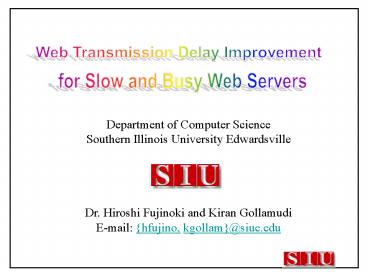HTTP Client/Server Model - PowerPoint PPT Presentation
Title:
HTTP Client/Server Model
Description:
Department of Computer Science. Southern Illinois University Edwardsville ... The elapsed time between the end of an inquiry on ... – PowerPoint PPT presentation
Number of Views:237
Avg rating:3.0/5.0
Title: HTTP Client/Server Model
1
Web Transmission Delay Improvement
for Slow and Busy Web Servers
Department of Computer Science Southern Illinois
University Edwardsville Dr. Hiroshi Fujinoki
and Kiran Gollamudi E-mail hfujino,
kgollam_at_siue.edu
2
Problem Definition
The elapsed time between the end of an inquiry
on a computer system and the beginning of a
response
- Long response time
Due to high web traffic load
- Transmission time
FAT look-up, following a sector-chain, multiple
clients etc
- Operating system overhead
3
Delay Causes
We have 3 different causes of delay
4
HTTP Client/Server model
- Response time
- Transmission time
5
Existing work for Client/Server model
The following are the existing techniques to
reduce response time and transmission delay
6
Object Packaging
To improve response time and transmission time by
- Single request for the multiple files
- Reduced network protocol overhead during the
transmission at routers
- CRC calculation overhead
- Memory copies
- Reduced number of packets by minimizing
fragmentation
- Reduced OS overhead at a web server
- Reduced FAT lookups
- Flow control and error control
7
Concept Of Object Packaging
Object Packaging
- Is a collection of web files in a web site
- Files are sequentially packed without compression
8
Packaging Format Of Object Packaging
- Object Information Field Contains the
information of the packed files
- Data Field Contains the contents of the
requested files
- Number of objects Tells how many packed files
are there
- A collection of the names of the contained files
- File Attribute Subfield Each file is a binary,
text, or executable
- A collection of the sizes of the contained files
9
Experiment Modeling
- Client Machine The host that requests the
server for the data
- Hub Broadcasts every packet to every port
- Traffic Monitor Monitors the all the traffic
(packets) that are passing
10
Experiment Design
- Files with 1K, 4K and 10K bytes are placed in
the server machine
- Factors measured for both the existing method
and - object Packaging
1. Average response time
2. Average bytes transferred
3. Number of Transferred packets
4. Transmission time
11
Experimental Output
- The figures represent all factors measured with
different file sizes.
12
Experimental Output
13
Summary
- Multiple file transmissions by object packaging
proposed
- No modification of an operating system at the
server side nor - transmission protocol at routers required
- Object packaging is efficient in reducing
response time and - transmission load and time
14
Future work
There are two on-going activities and future works
1. Measuring the CPU load, response time and
propagation delay on the server
2. Measuring all the above but for multiple
clients
1. Perform the experiments using a Gigabit
Ethernet cable
2. To observe the scalability
15
References
1. M. Arlitt and C. Williamson, Web Server
Workload Characterization The Search for
Invariants, Proceedings of the 1996 ACM
SIGMETRICS Conference on the Measurement and
Modeling of Computer Systems, May 1996, pp.
126-137
2. GVUs WWW User Surveys, Georgia Institute of
Technology URL http//www.gvu.gatech.edu/user
_surveys
3. J. Ousterhout, Why Aren't Operating Systems
Getting Faster As Hardware?, Proceedings of
Summer 1990 USENIX Conference, June 1990,
pp. 247-256
4. P. Druschel, Operating System Support for
High-Speed Networking, Communications of the
ACM, vol. 39, no. 2, September 1996, pp. 41-51
5. P. Markatos, Speeding-up TCP/IP Faster
Processors Are not Enough, Proceedings of
the 21st IEEE International Performance,
Computing, and Communications Conference,
April 2002, pp. 341-345
16
References
6. M. Busari and C. Williamson, On the
Sensitivity of Web Proxy Cache Performance
to Workload Characteristics, Proceedings of IEEE
INFOCOM,April 2001, pp. 1225-1234
7. J. Dilley, The Effect of Consistency on Cache
Response Time, IEEE Network, vol. 14, no.
3, May/June 2000, pp. 24-28
8. S. Glassman, A caching relay for the
Worldwide Web, Computer - Networks and ISDN
Systems, vol. 27, no. 2, October 1994, pp. 165-173
9. D. Lee, PreFetch Document Caching to Improve
Worldwide Web User Response Time, Master's
Thesis. Virginia Polytechnic Institute and State
University, March 1996
10. J. Mogul, Squeezing More Bits Out of HTTP
Caches, IEEE Network, vol. 14, no.3,
May/June 2000, pp. 6-14
11. Figures of Red hat and Windows from the
internet sites.
17
The End
Thank you !!!
18
Client Side Caching
- Reduced latency
- Reduced server load
- Reduced bandwidth consumption in a network
- Effective only when same files are repeatedly
requested
- Additional hardware or expertise is required
- No benefit if object is not cached
- May be unable to cache multimedia content
- Unable to cache dynamically generated content
Go To Previous Slide
19
Mirroring Technique
- Improves throughput
- Complete redundancy of data
- Fast recovery from a disk failure
- Expensive
- Low capacity
- No improvement in data access speed
Go To Previous Slide
20
Server Clustering
- Fail over
- Scalability
- Fault resilience
- Load balancing
- Requires investment for hardware
- Request dispatcher may be a bottleneck
Go To Previous Slide

